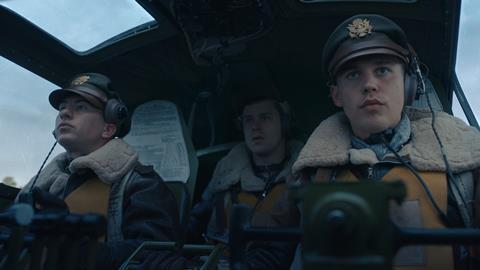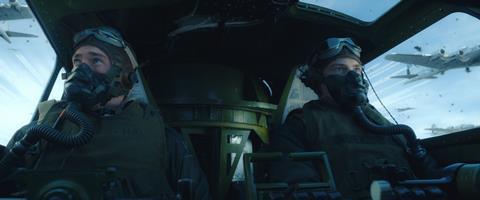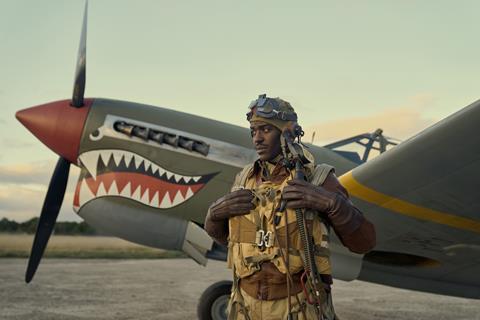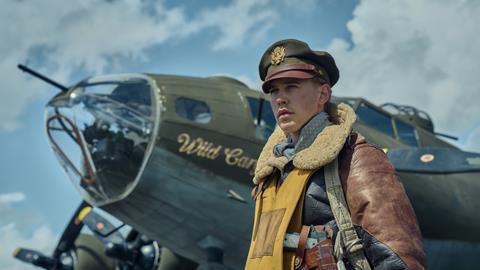Masters of the Air takes place over the skies of Nazi-occupied Europe and at the very least doesn’t flinch from the horrific conditions faced by men in metal tubes flying five miles above ground, writes Adrian Pennington.
The third series about how the US ‘won’ the Second World War from producers Steven Spielberg and Tom Hanks (Band of Brothers, The Pacific), Masters of the Air aimed to accurately recreate the Allied bombing missions with authenticity down to the weather conditions and topography the crews would have encountered in 1943.

“We started by studying all the diaries of the pilots flying the B17 Flying Fortress at the time,” explained Phil Arntz the show’s Aerial Director of Photography. “We then went through the script and picked the moments that required identifiable scenery in Europe.”
Arntz was working to a brief from VFX Supervisor Stephen Rosenbaum to capture high-resolution plates that would fit the geographical area of the actual missions and in a way that production could use across the series. Principal photography of the aerial scenes could only begin once these plates were captured and treated in post for playback on a Volume stage.
“Typically what you want when shooting background plates is to know what the foreground action is going to be first so you can compose it accordingly,” explains Rosenbaum. “For scheduling reasons we didn’t have that benefit here so we did previz in advance. We blocked out the action with the director’s guidance and I handed that to Phil and his team to try and adhere to the composition in the previz.”
Read more Behind the Scenes - Dune: Part Two
The nine-episode AppleTV series is directed by Cary Joji Fukunaga (No Time to Die), Dee Rees (Mudbound), Anna Boden and Ryan Fleck (Captain Marvel) with cinematography from Adam Arkapaw, Richard Rutkowski (The Americans), Jac Fitzgerald (Freaky Tales) and David Franco (Inventing Anna).
For their block of episodes 7 and 8, Rees and Rutkowski storyboarded shots prior to shooting in the Volume. “Dee had very clear ideas about how to unfold the action,” says Rutkowski. “She is driven by the information we need to drive the narrative rather than technical challenges.”
Shooting aerial action in the Volume
Apple had commandeered stages at Symmetry Studios near Aylesbury in Buckinghamshire where it constructed two Volumes, one of which was arguably the biggest built in the UK to date, and perhaps the largest anywhere. Rutkowski describes it as “avant-garde.”
The primary Volume was a horseshoe-shaped wall, 12m high by 30m across, complete with LED panel ceiling and a motion base in the middle. A second Volume was arrayed in a shallower crescent shape with SkyPanel array.
Both were used to shoot scenes in the B-17 which was reconstructed accurately to the inch by Production Designer Chris Seagers and divided into sections of set for tail, radio room, bomb bay, cockpit, fuselage and nose compartments. Multiple Sony Venice cameras were placed aboard the sets and around the Volume with camera movements synced to both the motion base and the wall projections of the previz played back through Unreal Engine.
“The plates went straight into post-production and we used them as background plates and environments,” says Rosenbaum. “With the array rig, we had 180-degrees of freedom to allow the directors to compose the shot in the foreground as they wanted knowing that photographically we had enough detail and canvas in the background plates to track with.

The show’s directors and DPs leant heavily on the video references and selected stills of lighting from the plate photography to light and compose the foreground achieving realistic reflections and highlights through the windows, plexiglass turrets and the metallic shell of the aircraft.
Rosenbaum says, “The plates served as a lighting guide and because the previz was all played back in real-time, the DP could say, ‘This lighting in Phil’s plate is really great so let’s try to match that in the previz’. They could do live using Unreal Engine which was driving the previz on the wall.”
Read more Nikon acquires RED digital cinema cameras
Directors could also request environmental effects like flak explosions or attack sequences of German fighters to be added in Unreal for playback on set.
“This wasn’t just for verisimilitude but for the actors to see and react to the landscape and for camera teams to re-cue and repeat camera movements,” explains Rutkowski. “We could tilt the stage and shoot towards the roof and everything remained in correct perspective.”
Cameras mounted on a technocrane could also have their movement 3D mapped to the background plates. Where any of the cameras and other kit were caught in the frame these were painted out in post. Artists also massaged the final footage shot in the Volume by rotoscoping, for example.
The series was shot on Sony Venice 2 with the cameras split into Rialto mode to fit into the fuselage in the Volume. A similar approach was used on Top Gun: Maverick (albeit with many scenes filmed ‘as live’ with actors genuinely pulling G-force manoeuvres in the air) and Michael Mann’s Ferrari.
The cameras were fitted with Petzval Primes custom-tuned by Panavision London. The rental house even established a temporary rental operation at Symmetry to service the production.
Lead DOP Adam Arkapaw who lensed the first four episodes had set the show’s LUT on 2018 documentary The Cold Blue which itself was composed of restored 35mm colour footage shot by esteemed Hollywood director William Wyler during 1943 onboard B-17 bombers. One of the cinematographers, Harold J. Tannenbaum, was killed when the bomber in which he was flying was shot down over France.
“Many of the US flyers had never been in a B-17 which weren’t pressurised or heated,” Rutkowski observes. “They had not been exposed before to the cruel cold temperature of the thin upper atmosphere at 25,000ft and the bone-shaking movement and terrifying conditions of being under attack at altitude.”
The visual look of barracks and POW camp
DIT Mustahab Tyebkhan was one constant across all nine episodes and he helped each DP follow Arkapaw’s lead in maintaining the show’s visuals and workflow.
Rees and Rutkowski’s block however required them to deviate from that path. Their portion of the story required visual looks for POW camps, where captured pilots were held, and the Italian base of Tuskegee (aka Red Tails) pilots that were distinctive from the look of the UK Air Force base, although all three were shot in the exact same spot in England.

To achieve this, Rutkowski did extensive prep and utilised light sources to reflect the different atmospheres of each new spot.
“We wanted scenes with the Red Tails to look warm, an appearance of honey, because of their unique role. These were men who were not allowed access to certain things back home but in the War, they were renowned as notoriously efficient and very brave. We wanted to give that feeling of optimism and heroism by having the sun warm their faces.”
Unlike the concrete blocks of the English base for the US aircrew the Red Tails’ barracks were made of wood, allowing Rutkowski scope to adjust the colour temp for warmth. Production designer Chris Seagers placed two or three replica planes on the field in front of the huts for shots that were then extended by VFX.
By contrast, the light in the POW camps was dimmed and grey whilst also not as grim as might be expected. According to Rutkowski, the Luftwaffe respected their enemy air force combatants enough to give them a degree of comfort which is reflected in the production design.
His research unearthed a detail that the Germans lit such camps with the lowest wattage light they could produce. A single source of light from a searchlight provided illumination for night exteriors. The team knew these scenes were accurate thanks to illustrations made at the time by Red Tail and POW Alexander Jefferson, portrayed by Branden Cook in the show.
“We only built six buildings for the POW camp and used every corner,” says Rutkowski who framed his shots to emphasise how cramped the spaces were.
The huts and POW camp were reconstructed from scratch using photo references of the actual base of the US bombers at Thorpe Abbotts in Norfolk and were yards apart from each other on land near Symmetry Studios. An old runway at the former RAF Abingdon in Oxfordshire was used for taxiing shots and to stage the control tower. Several replicas of B-17s which could be driven on electric wheels on location, required a whole team to maintain and dress them, for different battle damage. Scenes in Paris were filmed in a London a block away from Fleet Street.
When the Russians liberated the camps and marched the soldiers to Munich in winter (depicted in the final episode) production covered the ground with snow, an atmosphere enhanced by VFX.
The aerial mission
Aerial plates were shot with a three-camera array of RED V-Raptors by Arntz from a helicopter.
An episode depicting a bombing raid on U-boat pens in Trondheim, Norway was identified as the furthest location the aerial crew would need to travel to. From that end point, they built their own six-day flight plan across the Channel to France, to Belgium, The Netherlands including shooting windmills around Amsterdam and then over Germany, up to Denmark, Sweden and finally to Norway.

They also shot for a couple weeks over England capturing generic cloudscapes as well as the coastlines of Wales and Norfolk - that also doubles as the coastline of Normandy.
“We want to do a really good job of making the show historically accurate so we tried to structure the day to nail the time of day we needed, passing through and above cloud layers, and to extend the day to shoot sunrises and sunsets,” Arntz explains.
The REDs were aligned in a portrait configuration, one pointing right, one left and one straight ahead and controlled remotely by Arntz on an iPad from the cockpit. This enabled production to use the fully stitched panoramic output in a 2:1 aspect ratio, but also opened the door to selecting different sections of the plate.
“The three 8K feeds produce a 11K x 8K image when stitched which is comparable to the traditional stitched output of a six-camera array. You get so much detail in the shadows and highlights we can just give VFX the biggest negative possible so they can push it wherever they want in post.”
Not always plane sailing
It was not all plane sailing. Occasionally the Volume had to be shut down and rebooted which did lead to some delays.
“When you hit a roadblock on a Volume stage you are frozen. Suddenly you are no longer using it and you pivot the whole thing to more CGI and VFX so having the time to prep well in advance is my big takeaway from the experience,” Rutkowski says.
Read more Behind the Scenes: Percy Jackson and the Olympians
When production in the Volume couldn’t keep pace with the shoot schedule they built blue screen for a sequence in which a Tuskegee pilot struggles to keep his P-51 on a mission, which was shot outdoors using largely natural light.
“There’s almost a relentless need for real estate too,” adds Rutkowski. “To sell the realism of daylight in a Volume you need height above the stage and space between the camera and the subject. Sometimes even a painted backdrop is more realistic if that is what sells the scene.”
As much as they accomplished using the latest technology he says his priority is always to convey a connection between two people in a room. “The chief directive of any storyteller is how to get people to connect to your story and that is equally if not more important than operating a complicated camera move. Sometimes the challenge is a relatively simple one like how am I going to get this lens under the car?’”
A flying DOP
Rutkowski had worked as second unit DP on director Dee Rees’ 2017 historical drama Mudbound where he was called in by cinematographer Rachel Morrison to shoot aerial scenes of characters in B-25 bombers flying over Europe. Rees remembered this and made the call to get him on board for the project.

Equally serendipitous is that Rutkowski is a qualified amateur pilot, an experience he found useful on set. “I think it was helpful in being able to spot moments when a character is supposed to be flying but the actor might have had maybe four rehearsals,” he says. “You know, flying is a constant scanning, followed by immense concentrated focus on the instruments when necessary. I had a sense of that when helping on set for composition and verisimilitude. I knew how light should fall into the cockpits and what contrast should be because it is a very contrasty environment, unless flying directly into the sun which is a whole other issue.
He admits that being around such accurate replicas of nearly 80-year-old planes “fuelled the child in me.” He even got to fly an actual P-51 Mustang, now a trainer plane, used in the production.
“We had some downtime one day and the owner operator permitted me to go up in the P-51 and fly it. It was just a total thrill. One thing I noticed was that the plexiglass cocoon of the cockpit had this surreal ability to make you feel so much a part of the plane that your body was in flight.”
Read more Behind the Scenes: The Zone of Interest

























No comments yet